Piraeus Museum for Underwater Antiquities - The Competition Winners
By Bustler Editors|
Friday, Feb 22, 2013
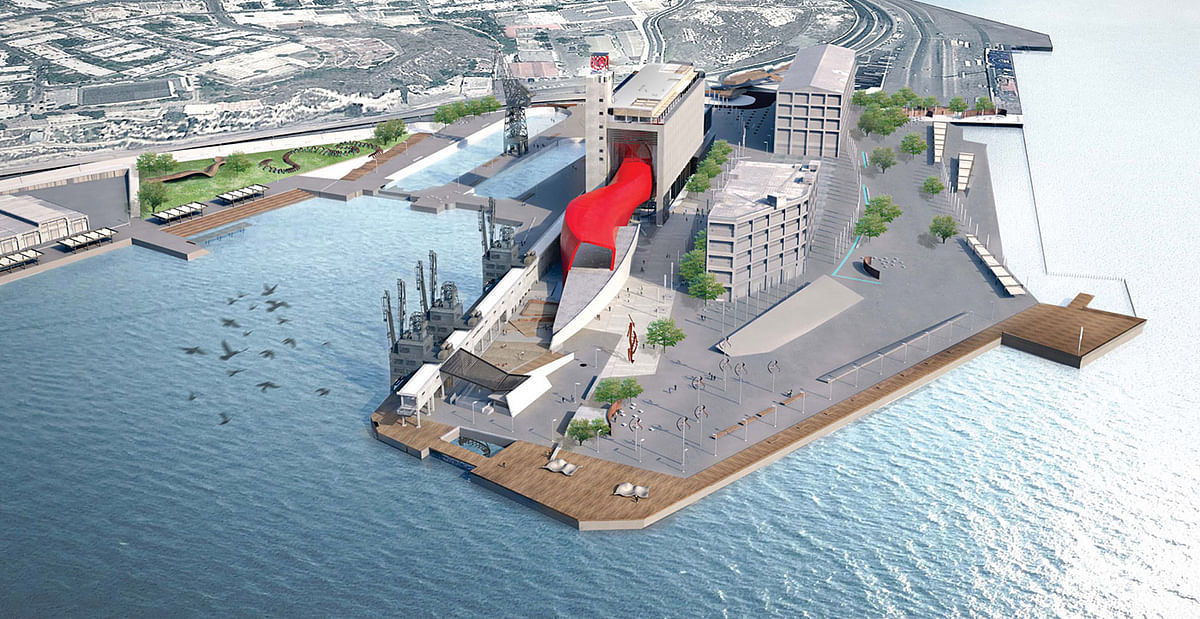
Related
Just a few days ago, results were announced in the international architectural competition Piraeus Cultural Coast - Museum of Underwater Antiquities. Now the organizers also released images of the five winning projects and nine honorable mentions. The brief calls for the conversion of an existing industrial facility in the port of Piraeus, Greece into a museum of underwater antiquities with redesigned open public spaces for outdoor activities.
1st Prize: Antonopoulos Evangelos, Vetta Thalia, Gavalas Georgios, Riga Maria - Kiriaki, Stamouli Anastasia, Pilarinou Maria
Short description of the proposal:
The restructuring of the coastal zone of the Port of Piraeus restores the broken relationship between the city and the sea. It takes recreational and cultural uses of various qualities and references, reflecting in the spirit of its planning, the hovering position of the Haetionian coast between land and water, urban and marine landscape, local and supralocal character. The flows of the city come to meet the flows of the marine routes which stream in the port. Urban fragments, green areas, and designed shores are the basic tools that compose the typology of the new coast. The planning of the intervention aims at redefining the activity of people and re-introducing the human scale in the specified area, without concealing the great antithesis that the physiognomy of the commercial port already contains.

The new Museum of Marine Antiquities redefines and amplifies the self-marking of the historic building of Silo as an established landmark of supralocal character. Modern architectural idioms converse with the old typology, enrich its physiognomy and reflect outwards the new function. The stern introvert machine-building of the past, claims its contact with the open space, revealing hidden sides to the city and “emptying” freely its interior towards the sea. The content of the building takes the shape of an organic form which flows outwards, as a reminder of a ship’s hull or a sea monster. The plasticity and the modern character of this metal form dialectically contrast with the Cartesian sternness of the monolithic block of concrete of the existing building.

The interior of the new figure presents by means of high edge technology, a complete tour through the history of the relation of man with the sea in Greece and the broader region, maintaining in the area of the form situated within the limits of the old building, the introversion of the sea depths and offering gradually the view of the open horizon facing the sea. The addition of smaller secondary building blocks which service the special supportive requirements of the Museum, follow discretely the micro-scale of man and shape different qualities of reception when facing the city, the coast and the designed plan οf the Cultural Park.
2nd Prize: Uleia Andrei, Traian Bompa, Cristina Chelarescu
Short description of the proposal:
The challenges of this project are strong: “Redesign of the existing cereals’ stock house building facilities (SILO) and its surrounding open space into a Museum for Underwater Antiquities”.
The site is an exceptional, poetic port: large, atypical volumes, sometimes very long, sometimes very high, the depth of fi eld, the lines of dull lighting, the mass of the silos, the tanks adding a strong extraterritorial atmosphere.
A port skyline with its singular figures.
We expect a building that represents both the antiquities and also the world of the sea and navigation, the openness to other horizons.
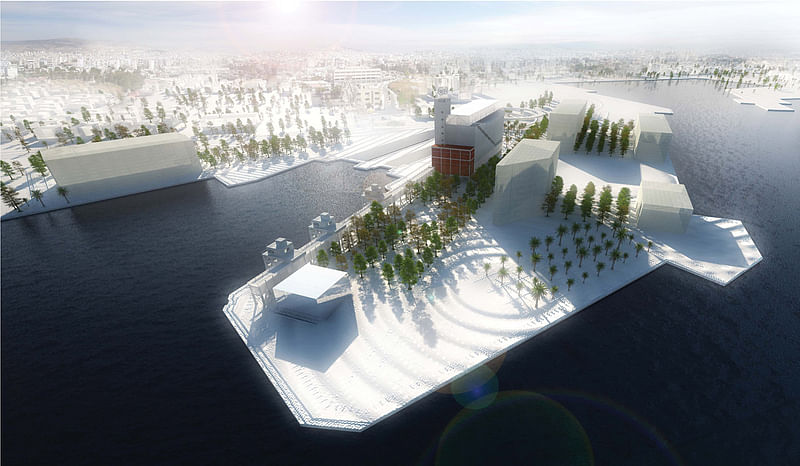
Ship space / Amphora space
The architectural concept is based on the intention to expose the objects recovered from the sea bed not as relics, some meaningless dead objects but as objects partially recovering the original meaning. The museum is structured around a strong vertical gesture, situated in a monumental space derived from ancient amphorae as well as the shape of ships.

The building is simultaneously a ship that develops and supports the idea of the journey and an amphora built a symbol for the idea of content. The journey is not only the one that brought the antiquities to sea but also the one that the archeologists take in order to discover them. It is a trip back and forth between civilizations, in search of content, of truth.
The duality of the architectural concept emphasizes the initial functional duality: a building for grain storage and a component of a transport network.
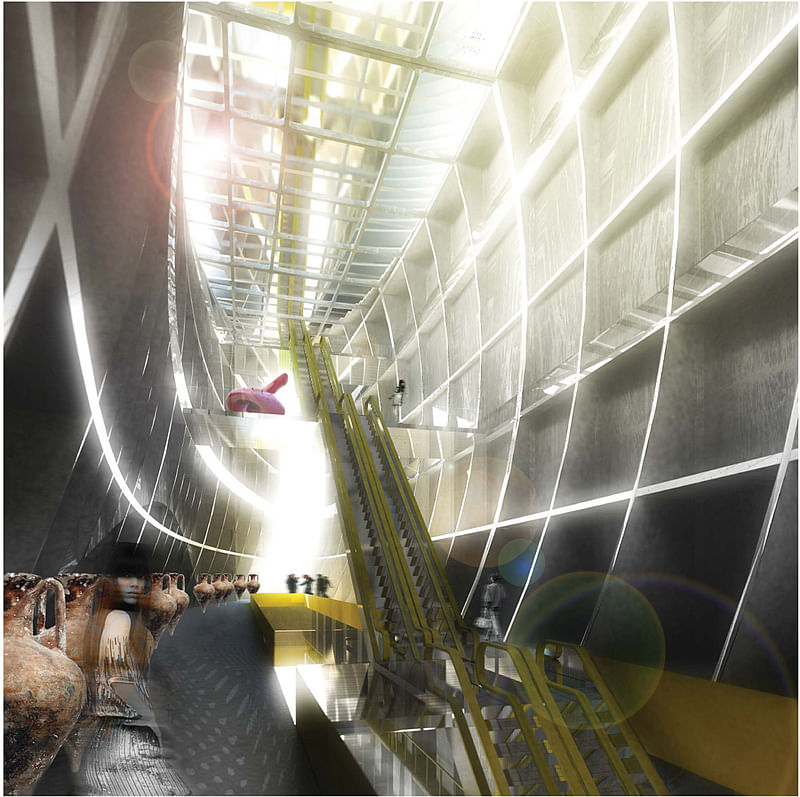
Keeping the impact it has on the port skyline, we mainly focused our intervention to the interior: a monumental cut ilustrating the same dual approach: targeting the city but also the sea: space – journey / space- content.
The inner atrium has the proportions of a cargo: 1 of 8 plan and it turnes towards the water, curves to the harbor.
The Clock Tower, the port symbol is highlighted by longitudinal translucent volumes. The building is essentialized , decomposed into parts: the massive warehouse silhouette and the slim fi gure of the tower are revealed by superposing the delicate translucent volumes.
3rd Prize: Kizis Ioannis, Kizis Konstantinos, Mpelavilas Nikolaos, Trova Vasileia
Short description of the proposal:
The re-use of an industrial monument presupposes a balance between the modern intervention and the recognition of the historical tradition. The proposed design:
- restores the original Silo unit,
- enhances what remains of the industrial port landscape,
- re-utilises materials and building parts as “spolia”, and
- introduces elements of contemporary design, yet retaining its past ‘identity’.
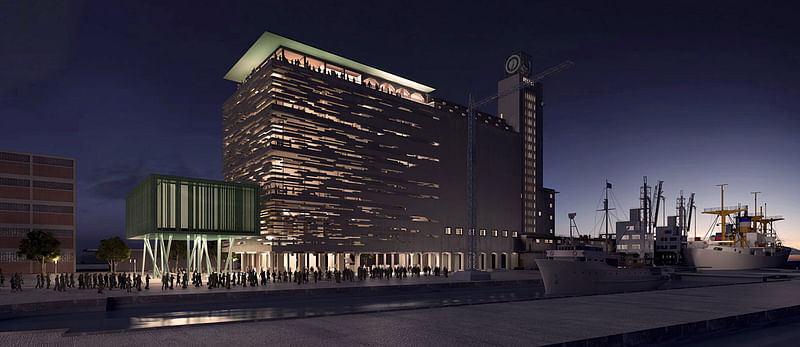
The museum’s concept is based on the submersion from the highest level towards the ground floor where the cycle of the visit in the shop and the café comes to a close.
The aim of the proposal is to convey the new contemporary character of the complex by recycling the material of the industrial monument. On the basis of ‘inverted archaeology’ it proposes the detachment of building mass from the Silo and its re-usage in the new project in order to connect with its roots.
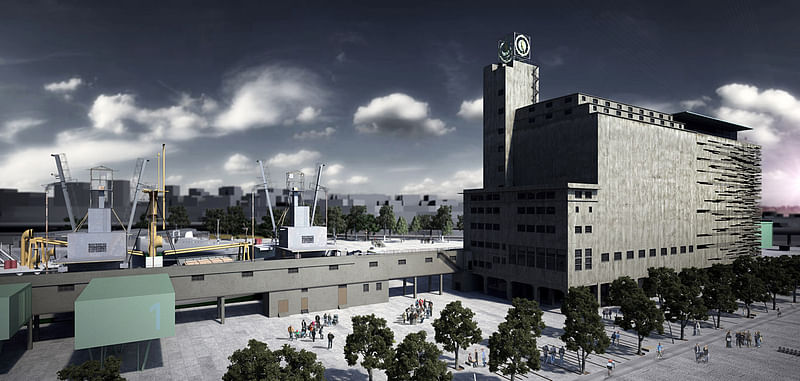
The structure of the Silo is receptive to such an approach: the present complex is the result of extensions on the 1936 original building. The minimum operational unit consists of the first body of cellules which are preserved. In the second body of the original building minor internal interventions are proposed in order to accommodate the Museum of Underwater Antiquities with the corresponding preservation of the 1936 façades.
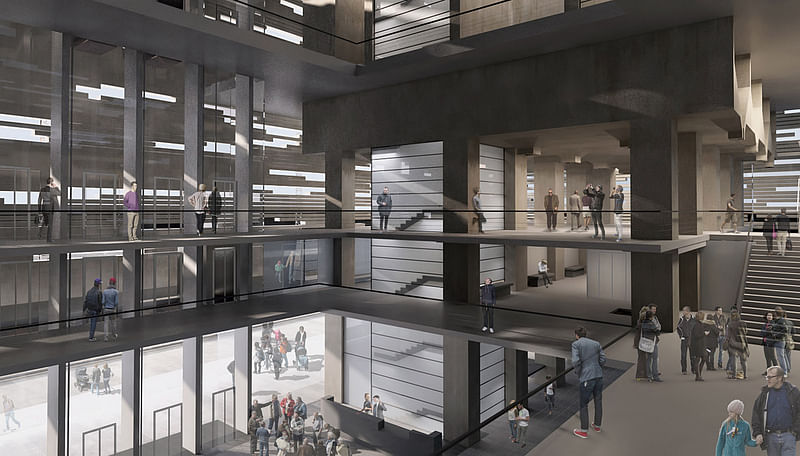
The 1962 wing is converted from an industrial shell into an extrovert public building. The removal of the third body liberates a high area in the heart of the Museum, and opens a glazed entrance hall on the ground-floor. Within it visitors ‘read’ the anatomy of the pre-war Silo, cross bridges and mount staircases leading to individual exhibition unities and may return to the starting point of the visit on transparent elevators. The restaurant with its panoramic view is situated on the last level. The glazed perimeter of the fourth body is given to visitors, allowing a view to the outside, while a see-through, perforated curtain-wall made of the ‘spolia’ of the cellules saves energy.
A landscape with rough characteristics is proposed for the public surrounding area. The proposal was based on fragments of the historical area of the Cultural Coast which could be revitalised as a unified concept. Focal point is the area between the Silo and the Port Warehouses, while lateral tracings augment open air and covered spaces.
4th Prize: sparch SAKELLARIDOU / PAPANIKOLAOU ARCHITECTS (Dr. Sakellaridou Eirini, Papanikolaou Morpho, Mavrou Chrysokona)
Short description of the proposal:
DIVING (to the bottom of the sea) _ EMERGING (to knowledge)
Τhe Museum becomes a spatial narrative based on experience; it awakens mind and fantasy, it brings fragments from the depths to the surface and transforms them to knowledge.

The concept is a ‘continuous flow of diving and emerging’, from the level of the sea to its depths and back again to knowledge. A continuous flow of people, via escalators sculpted to the body of the Silo, gives rise to the ‘sea level’ placed on top. Visitors rise, enjoy the view of the horizon and enter the mysterious world of the Museum in order ‘to dive to the sea-depths’. A large internal void, sculpted through vertical concrete-ribs in reference to the Antikythira Mechanism, becomes the heart of the museological narrative.

A continuous belt of ramps winds around the internal void, bringing visitors deeper to the ‘bottom of the sea’. Natural light enters from above, light, shadows and flows of people wind around the shipping-wrecks.
On top of the building, mirrored in a water surface that disolves to the horizon, emerge the winding forms of the cafe and the restaurant.

For the Sea Front a new border between the natural and the artificial is created that multiplies the sea-land interface, based on the strong presence of the existing dry-docks and the notion of interpenetration.
5fth Prize: Ventura Trindade Architects LDA, Joao Maria Ventura Trindade, Site Specific – Architecture LDA, Patricia Marques Costa
Short description of the proposal:
1. The landscape is an accumulated fabric of marks of a place, a set of relations that in each inhabited space was shaped by overlapping.
The superficial image of a territory very often hides the depth of time that occurs between its origin and its contemporary configuration.
The successive overlapping, made from deleting and rewriting, never fully erases the previously imprinted signs, necessarily producing in each intervention a dialogue between the past and the future.

In a place like Piraeus, and addressing a theme such as the ground, the complexity of the depth of time of the place cannot stop being the central theme of the work related to the outdoor spaces.
The project develops the idea that the floor and the ground are rich in content, history, overlapped signs throughout time, lost logics, marks in which their meaning became diffuse.
The analysis of the records that register each transformation of a place, the overlapping of those maps and charts, allow deciphering an important part of depth that the ground contains but its first appearance does not reveal.
We propose to recover traces of the history of the construction of the place, incorporating them as a base of the new proposed structure, and make its operative and functional character a significant part of its future cultural program.
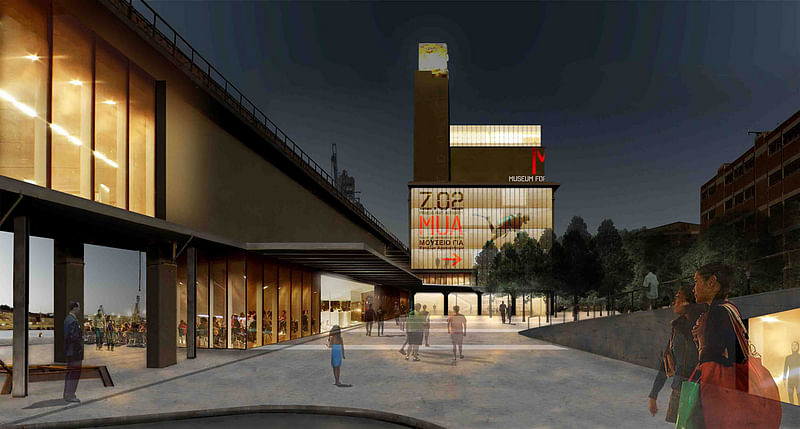
2. The subsistence in time of a building often determines the transformation of its program into new uses.
Strangely, the constructions that better respond to the specificity of the function for which it was conceived seem to also be those that better adapt to shelter new uses.
A cereal storage Silo, vertically organized in a rigid formal and functional configuration adapts in an unexpectedly simple manner to its new program as a museum.
Probably because, as before, it is in the analysis and comprehension of the past and character that its transformation is based on.
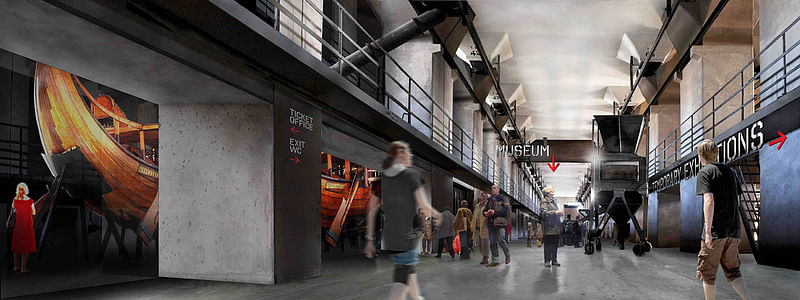
The peculiar manner of transporting the cereal in the old warehouse, vertically accessing the top and after driven by gravity, it ends up establishing analogies with other contemporary museum spaces, while symbolically translating the idea of submersion that the museum program suggests.
The visitor is invited on a trip that goes from the surface to the very bottom, in a strict sense and in a broad sense, while also offering a parallel understanding about the space in crosses.
Also check out the nine honorable mentions in the image gallery below. All images courtesy of Piraeus Cultural Coast - Museum of Underwater Antiquities competition.
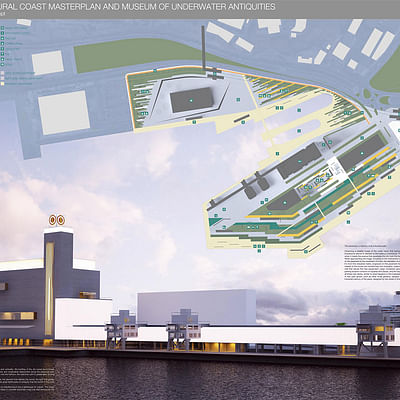
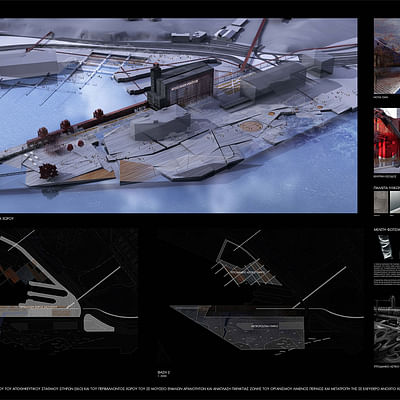
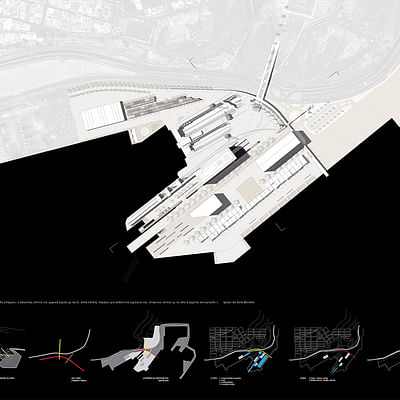
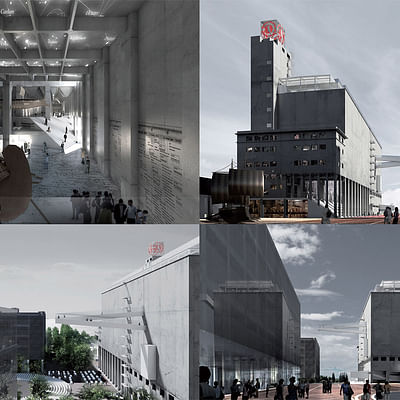

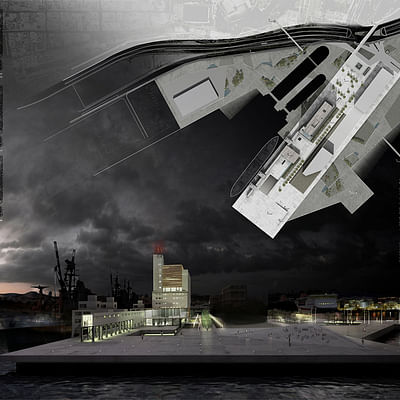
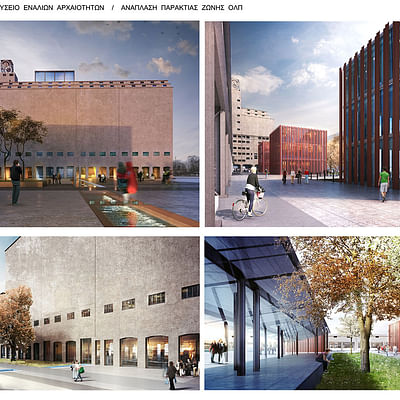

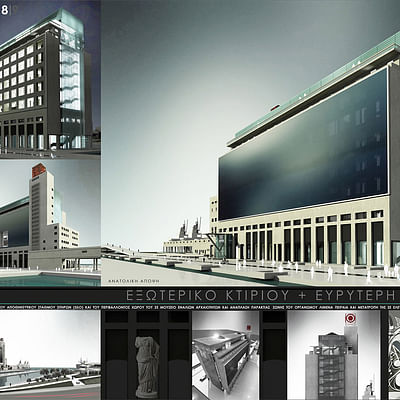

Share
0 Comments
Comment as :